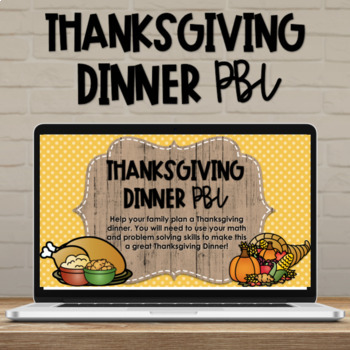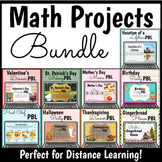Thanksgiving Math Project Based Learning PBL
- Google Slides™

Also included in
- This bundle includes 9 of my math projects (PBLs). These are 100% digital via Google Slides™. Students practice real life scenarios while integrating math. This are mostly geared for 5th grade but could be used for 4th or 6th depending upon ability. I love making and giving these projects to my studPrice $22.99Original Price $27.00Save $4.01
Description
Are you looking for a thanksgiving math project for your 4th or 5th graders? This listing is for my Thanksgiving Dinner PBL. Students will be given a 16 slide Google Slides™ Presentation in which they will pretend they are planning a Thanksgiving dinner for their family. They will be given a budget and must get the house cleaned, rent table and chairs, purchase tablecloths/tableware, prepare the turkey, purchase ingredients for 3 recipes, calculate cooking times and watch the football game for their favorite team.
Students will need access to a computer and both you and the student will need access to Google Drive™. You DO NOT need Google Classroom™ to assign this activity to students.
Concepts/Skills Covered
- Budgeting
- Multiplication (1 x 1 and 2 x 1)
- Area & Perimeter
- Written Expressions
- Add & Subtract Money (Decimals)
- Add or Multiply Mixed Numbers
- Convert Minutes to Hours
- Calculating Time
How to use this resource:
- Math Centers
- Independent Practice
- Early Finishers
- Extension for high flyers
Standard Alignment:
CCSS: 4.NBT.5, 4. NF.4, 4.MD.3, 4.MD.8, 5.OA.2, 5.NBT.7, 5.NF.6
NC SCOS: 4.NBT.5, 4. NF.4, 4.MD.3, 4.MD.8, 5.OA.2, 5.NBT.7, 5.NF.6
Here are some other resources you might enjoy!
Get them all here with a Bundle!
Want this same resource in Spanish? Click the link below!
Proyecto planea tu cena de acción gracias práctica de matemáticas
Check out this blog post that highlights this resource!
If you enjoyed this resource don’t forget to FOLLOW my store for more awesome products and please RATE this product for TpT credits that you can use towards the purchase of more products!
Let’s Connect!
Follow me on my Website to get ideas of activities you can do in your own classroom!






